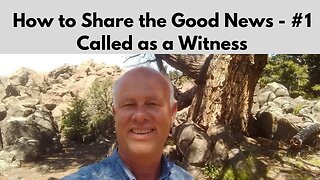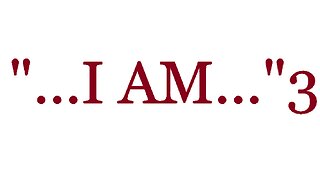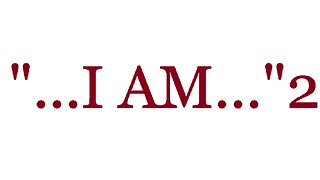How to Share the Good News – Part 4 - Your Personal Testimony
How to Share the Good News – Part 4
Your Personal Testimony
Text: 1 John 5:11-13
What is a testimony? Something you have seen or heard for yourself.
If you were called as a witness in a court room, you would not tell what you thought had happened, what you wished had happened, or what someone else said had happened, you simply tell what you knew had happened from your own experience.
Ver.11 This is our testimony!
(Google – The God Test)
Salt Evangelism - Col.4:6 “Let your speech always be with grace, seasoned with salt, that you may know how you ought to answer each one.”
S - Start a conversation – take the initiative.
A - ask a question – “Are you a spiritual person?” etc.
L - listen
T - tell the story – “Can I share with you how I came to know Jesus?”
I want to take the rest of this time to talk about our personal testimony.
Our personal testimony is the best tool we have to talk to someone about God.
People can argue the validity of the Bible, but they can’t argue with your experience of what God has done for you.
Many Christians don’t witness simply because they don’t know how.
1 Peter 3:15 “…Always be prepared to give an answer to everyone who asks you to give the reason for the hope that you have….”
Many haven’t prepared or organized what to say so their attempt is like trying to put a gig-saw puzzle together with no picture and they end up stumbling through the process that can leave them saying, “I’m never doing that again.”
So I want to go through some step by step mechanics as to how to organize your testimony to be an effective tool.
In organizing this, I believe it is important to write it out.
By doing so, you mentally focus on your personal experience with a new perspective.
It will also help you to organize the details into progressive, everyday language that leads to a conclusion.
Not rambling on and on, going back to fill in forgotten points, then ending with “and why did you tell me all this?”
Since the aim of our testimony is to share “How I came to know Jesus,” that’s the focus.
Christian jargon is so hard to get away from that it takes effort.
Unfortunately, the terms, “becoming a Christian”, “being saved”, “being born-again”, “trusting in Christ,” are words and phrases that mean different things to different people, so it’s best not use those terms.
Here is a suggested outline to help you write your testimony.
A. Before I came to know Jesus.
B. Then I came to know Jesus.
C. Now that I know Jesus.
A. Before I came to know Jesus - In talking about your life B.C. the mistake some make is to spend too much time explaining in depth of sin in your life, or by almost glorying in the memory.
The point you want to make is you came to realized you were lost, without hope and separated from God.
B. Then I came to know Jesus – Not everyone who receives gives their life to Jesus has a deep emotional experience.
Be pictorial in this part, but don’t leave the idea that “this” is how you will feel, or “this” is what you will experience.
The goal is to share the turning point in your life.
C. Now that I Know Jesus – Our tendency is to generalize our life now, such as, now life is wonderful, It’s been great…
What does that mean?
Be specific about the benefits life has for you now.
For instance: I have a personal relationship with Jesus, I have peace in life, I am no longer afraid of death, I now have direction in my life…etc.
However don’t leave the impression that you have “arrived” and have no problems.
Now what?
Why do we want this tool, our personal testimony, in our toolbox?
To influence someone to want Christ.
If by now you can see they are with you and want you to continue, you take the next step of leading them to Christ. (What we talked about last week.)
If they are not there, don’t push them, but leave the door open for a future time.
-
 28:28
28:28
Gary Wayne Bible Teaching
4 months agoHow to Share the Good News – Part 1 - Called as a Witness
119 -
 29:25
29:25
gnhr1
3 months agoHow to Share the Good News – Part 5 ~ Go Make Disciples
19 -
 8:29
8:29
Jesus' Love Letters ... Liebesbriefe
5 months agoShare the Good News ❤️ You can save Lives as this Testimony shows
100 -
 9:54
9:54
The Good News 2
1 year ago"...I AM the Way — and the Truth and the Life..."3--The Good News 2
10 -
 1:20
1:20
The Good News 2
1 year ago"...I AM the Way — and the Truth and the Life..."2--The Good News 2
3 -
 1:42:45
1:42:45
JosephZLive
6 months agoQuestions Answers & Testimonies!—HAPPY THANKSGIVING!!
2.98K6 -
!["...and after that the [certain] judgment..."12--The Good News 2](https://hugh.cdn.rumble.cloud/s/s8/1/K/Z/j/X/KZjXh.0kob-small-...and-after-that-the-certa.jpg) 4:30
4:30
The Good News 2
1 year ago"...and after that the [certain] judgment..."12--The Good News 2
14 -
!["...and after that the [certain] judgment..."3--The Good News 2](https://hugh.cdn.rumble.cloud/s/s8/1/f/r/3/h/fr3hg.0kob-small-...and-after-that-the-certa.jpg) 9:38
9:38
The Good News 2
1 year ago"...and after that the [certain] judgment..."3--The Good News 2
38 -
!["...and after that the [certain] judgment..."11--The Good News 2](https://hugh.cdn.rumble.cloud/s/s8/1/O/Y/1/r/OY1rg.0kob-small-...and-after-that-the-certa.jpg) 3:19
3:19
The Good News 2
1 year ago"...and after that the [certain] judgment..."11--The Good News 2
1 -
!["...and after that the [certain] judgment..."10--The Good News 2](https://hugh.cdn.rumble.cloud/s/s8/1/a/X/9/q/aX9qg.0kob-small-...and-after-that-the-certa.jpg) 10:40
10:40
The Good News 2
1 year ago"...and after that the [certain] judgment..."10--The Good News 2
2